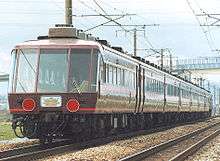Soyokaze
|
A preserved 189 series EMU with a Soyokaze headboard, December 2004 | |
| Overview | |
|---|---|
| Service type | Limited express |
| Status | Discontinued |
| Locale | Honshu, Japan |
| First service | 26 July 1968 |
| Former operator(s) |
JNR JR East |
| Route | |
| Start | Ueno |
| End | Naka-Karuizawa |
| Distance travelled | 146.5 km |
| Line used | Shinetsu Main Line |
| On-board services | |
| Class(es) | Green + Standard |
| Technical | |
| Rolling stock | 157 series, 181 series, 183 series, 185 series, 189 series, 489 series EMUs |
| Track gauge | 1,067 mm (3 ft 6 in) |
| Electrification | 1,500 V DC overhead |
The Soyokaze (そよかぜ) was a limited express train service in Japan introduced by Japanese National Railways (JNR) in July 1968, and later operated by the East Japan Railway Company (JR East) between Ueno in Tokyo and Naka-Karuizawa on the Shinetsu Main Line in Nagano Prefecture.[1]
Rolling stock
Services were originally formed using 157 series EMUs, and services later used 181 series, 183 series, 185 series, 189 series, and 489 series EMUs.[1][2]
Formation
9-car 489 series formations operating in later years were typically formed as shown below, with car 1 at the Ueno end.[2]
| Car No. | 1 | 2 | 3 | 4 | 5 | 6 | 7 | 8 | 9 |
|---|---|---|---|---|---|---|---|---|---|
| Numbering | KuHa 489 | MoHa 488 | MoHa 489 | SaRo 489 | MoHa 488 | MoHa 489 | MoHa 488 | MoHa 489 | KuHa 489 |
| Accommodation | | | | | | | | | |
History
Soyokaze services were first introduced on 20 July 1968 as seasonal limited express servies operating between Tokyo and Naka-Karuizawa to supplement the Asama services which operated between Ueno and Nagano.[1] The services initially used 157 series EMUs, which had been removed from former Hibiki services in September 1964.[1]
From 1969, 181 series EMUs, also used on Asama services were introduced on Soyokaze services.[1]
When first introduced, Soyokaze services featured reserved accommodation only,[1] but from 15 November 1982, non-reserved cars were also included.[3]
From the start of the revised timetable on 14 March 1985, 9-car 489 series EMUs were introduced on Soyokaze services.[3]
From 3 December 1994, Soyokaze was down-graded to become an occasional service run between Ueno and Nagano, and was phased out before the opening of the Nagano Shinkansen.[3]
Special services
Salon Express Soyokaze

Seasonal Salon Express Soyokaze services operated between 28 April 1984 and 5 May 1988 using the Salon Express Tokyo Joyful Train locomotive-hauled trainset.[3]
Revival Soyokaze

On 30 and 31 August 2003, JR East operated a special Soyokaze service between Ueno and Yokokawa using 189 series EMUs.[4]
On 15 July 2012, JR East ran a special Soyokaze service between Ueno and Yokokawa using a 185 series EMU in "Amagi"-style JNR era livery.[5]
On 8 September 2012, JR East ran a Soyokaze service between Ueno and Yokokawa using a 185 series EMU in "Amagi"-style JNR era livery. The Shinano Railway also ran a special Soyokaze limited express service between Karuizawa and Ueda on the same day, as part of the 15th anniversary celebrations of the creation of the Shinano Railway.[4]
See also
References
| Wikimedia Commons has media related to Soyokaze. |
- 1 2 3 4 5 6 Teramoto, Mitsuteru (July 2001). 国鉄・JR列車名大辞典 [JNR & JR Train Name Encyclopedia]. Tokyo, Japan: Chuoshoin Publishing Co., Ltd. pp. 320–321. ISBN 4-88732-093-0.
- 1 2 列車名鑑1995 [Train Name Directory 1995]. Japan: Railway Journal. August 1995. p. 40.
- 1 2 3 4 JR特急10年の歩み [10 Years of JR Limited Express Trains]. Japan: Kousai Shuppansha. May 1997. p. 207. ISBN 4-330-45697-4.
- 1 2 "189系特急「そよかぜ」軽井沢~上田間で運転" [189 series "Soyokaze" limited express run between Karuizawa and Ueda]. Tetsudō Daiya Jōhō Magazine. Vol. 41 no. 343. Japan: Kōtsū Shimbun. November 2012. p. 74.
- ↑ "7/15, OM08編成による特急"そよかぜ"運転" [15 July: "Soyokaze" limited express run using set OM08]. Japan Railfan Magazine. Vol. 52 no. 618. Japan: Kōyūsha Co., Ltd. October 2012. p. 170.
.svg.png)